
Charter School Capital, the nation’s leading provider of growth capital and charter school facilities funds to charter schools, announced today that its facilities arm, American Education Properties (AEP), has purchased the building located at 600 Tommy’s Road in Goldsboro, N.C., from American Charter Development for $9.2 million. Funded earlier this summer, the acquisition provides a long term home for current tenant, Wayne Preparatory Academy, a charter school currently serving grades K-6.
Acquisition of the Wayne Preparatory Academy property is the first charter school facilities funds transaction by the company in the state of North Carolina. It was made possible through a $500 million pool of capital launched in 2014 designed specifically for charter school facilities needs. Currently there are 41 charter school properties under management, $450 million, and the company continues to increase its pool of available capital earmarked specifically for charter school facilities financing.
“We are very pleased to empower Wayne Preparatory Academy with a permanent home, and fully intend to allow the school’s administrators complete access and full control of their building,” said Stuart Ellis, CEO of Charter School Capital and AEP. “With a student body that is at capacity, and a healthy waiting list, Wayne Preparatory Academy is by all accounts growing, and we look forward to expanding its facility to accommodate that growth.”
A 31,469 square foot complex situated on a 50-acre parcel, the Wayne Preparatory Academy facility was built in 2014. The school has 17 years remaining on a 20-year lease, which the company will assume and reconfigure as part of the transaction.
The company will begin an expansion of the Wayne facility to accommodate growth of the middle school population through the 8th grade, which is planned for the 2018/19 school year. Wayne Preparatory Academy will also add a high school to its program once the facility is built out.
“There is more to this transaction than simply financing. It is Charter School Capital’s testament of support for the growth and future of Wayne Preparatory Academy,” said Taft Morley, chief operating officer of American Charter Development. “We have been delighted to support the school through its growth thus far, and are heartened in knowing that the school facility will be a top-notch environment fostering excellence in education for many years to come.”
Today, more than 1 million students find themselves on waiting lists for their local charter schools. The National Alliance for Public Charter Schools continues to highlight the lack of facilities options available to charter schools as a major issue charter leaders face. To meet this demand, charter schools require facilities that address the unique growth needs of each school and community and require access to charter school facilities funds to expand. Charter School Capital focuses solely on charter school needs, providing customizable facilities financing options to charter schools. Charter leaders retain control of their buildings and are afforded the flexibility to make the modifications necessary to expand their enrollment and academic programs.
To date, Charter School Capital has invested $1.5 billion to 550+ charter schools supporting 650,000 students across the country. Currently we have more than 40 charter school properties under management.
For more information on how Charter School Capital can help you assess your charter school’s facilities needs, check out our website and contact us at GrowCharters@CharterSchoolCapital.org.
Author: Grow Schools, formerly Charter School Capital
 JOIN OUR WEBINAR ON WEDNESDAY, AUGUST 16th!
JOIN OUR WEBINAR ON WEDNESDAY, AUGUST 16th!
What’s the latest in digital marketing today for charter schools? How is digital marketing helping benefit your student enrollment and charter school funding efforts? How are you using digital marketing to engage with your school community?
Join us on Wednesday, August 16th at 9:00 a.m. PDT / 12:00 p.m. EDT for an informative webinar featuring a high-level overview of the digital marketing landscape and what key platforms and programs charter leaders can incorporate into marketing efforts. We will also talk about what types of programs will help in brand awareness, community engagement and student enrollment. Speakers will include Kim Brater, our VP of Marketing who will be joined by Michael Barber, Founder of barber+hewitt.
Register today!
 Charter School Capital’s facilities arm, American Education Properties (AEP), has acquired two Florida charter school facilities for $30.5 million from ESJ Capital Partners and MG3 Developer Group.
Charter School Capital’s facilities arm, American Education Properties (AEP), has acquired two Florida charter school facilities for $30.5 million from ESJ Capital Partners and MG3 Developer Group.
The charter schools operating in the two facilities are Renaissance Charter School at University in Tamarac, Fla. and Kid’s Community College Southeast Riverview in Riverview, Fla. The Renaissance property was acquired for $22,296,330, and the Kid’s Community College property was acquired for $8,208,100. As part of the acquisition, the company has assumed the existing 20-year leases on both properties, which expire in 2032 and 2033, respectively. The two properties encompass a total of 134,000 square feet on 11.81 acres.
This acquisition marks AEP’s second transaction with ESJ Capital Partners and MG3 Developer Group. In late November, 2016, AEP/Charter School Capital acquired five charter school facilities from the sellers.
“It is such an honor to positively impact the future of the nearly 2,000 students that attend these two impressive Florida charter schools,” said Stuart Ellis, president and CEO of Charter School Capital. “We enjoyed working once again with ESJ and MG3 to arrive at terms that will give the charter school operators the peace of mind that comes in knowing their facilities are securely theirs to operate for years to come.”
Renaissance Charter School at University operates as part of Broward County Public Schools. Located about 10 miles northwest of the Fort Lauderdale business district, the charter school opened in 2012 and will serve 1,426 students in the 2017-18 school year. Managed by Charter Schools USA, one of the oldest and largest charter management organizations (CMO) in the country, the K-8 charter school operates in one 105,002 square foot building on 8.91 acres. The building was originally constructed in 1982 and renovated in 2015.
Kid’s Community College Southeast Riverview operates under the Hillsborough County School District. Located about 15 miles southeast of the Tampa business district, the charter school opened in 2003 and is slated to serve 397 students in the 2017-18 school year. The K-8 charter school operates on a 2.9-acre parcel in a single two-story building built in 2013 that is comprised of 28,998 square feet. It is independently operated by Kid’s Community College, a CMO that manages a total of eight charter schools serving Pre-K through high school.
Today, more than 1 million students are currently on charter school waiting lists. The National Alliance for Public Charters schools continues to highlight the lack of facilities options and funds for charter facilities available as a major issue charter leaders face. To meet this demand, charter schools require facilities that address the unique growth needs of each school and community and require access to capital to expand. Charter School Capital focuses solely on charter school needs, providing funds for charter facilities that are customizable. Charter leaders retain control of their buildings and are afforded the flexibility to make the modifications necessary to expand their enrollment and academic programs.
To date, Charter School Capital has invested $1.5 billion to 550+ charter schools supporting 650,000 students across the country. Currently we have more than 40 charter school properties under management.
For more information on how Charter School Capital can help you assess your charter school’s facilities needs or provide funds for charter facilities, contact GrowCharters@CharterSchoolCapital.org. Also check out more facilities information on our website.
 Charter schools operating in conflict with local school districts is an issue that’s been around for as long as we have had charter law. As such, we are reliant on state legislation to make collaboration happen more. The U.S. Department of Education’s Charter Schools Program (CSP) has a few key roles in supporting this, they:
Charter schools operating in conflict with local school districts is an issue that’s been around for as long as we have had charter law. As such, we are reliant on state legislation to make collaboration happen more. The U.S. Department of Education’s Charter Schools Program (CSP) has a few key roles in supporting this, they:
- Strengthen authorization
- Provide access to facilities and funding
- Provide enrollment and services for disadvantaged students
- Support expansion and replication (including ties to low-performing schools).
The Center on Reinventing Public Education’s (CRPE) ongoing research helps track collaboration efforts between charters and district schools across the nation. They recently released a report, “How States Can Promote Local Innovation, Options, and Problem-Solving in Public Education” which covers this topic. Some of the key report findings include:
- Collaboration is often treated as a “side project” or “forced marriage”
- Local politics impact incentives and the likelihood of success
- Cities that do sustain progress are working within local constraints and making smart choices on what to collaborate around
The National Charter School Resource Center recently presented a webinar covering these issues and what organizations like the CSP and CRPE are doing to help. This session included two panelists working with CRPE, Senior Research Analyst Sarah Yatsko and Jordan Posamentier, Deputy Director of Policy. They share their research gleaned from studying the role of collaboration between local district schools and charter schools.
Facilitator Alex Medler, Senior Director of the National Charter Schools Resource Center, led the discussion around three key issues local districts face – state mindset, leveraging funding grants and resolving local district-charter conflicts to clear the path for collaboration.
The overarching focus of the discussion was on the state’s role in collaboration between local districts. When applying for a federal grant, every state is required to explain in their application how they plan to support collaboration, but deciding how to apply funding toward local district-charter collaboration doesn’t usually end up being a high priority.
“Given the competitive nature of school choice, limited education funding and rampant misconceptions on both sides, this is not surprising,” said Medler.
Although the history between charters and traditional district schools has been contentious, things are starting to change. Traditional district schools and charters are increasingly seeing the value in coming together. But the role of the state in fostering cross-sector collaboration is essential.
“The way the state thinks about district-charter relations, problem-solving and collaboration has a trickledown effect to the local level. Without state involvement, kids lose opportunities due to sector divide, sectors resist coming together on their own and need strong leadership to insist on forging ahead despite politically challenging environments. State leaders can influence local tone by adopting mindsets conducive to collaboration. This in turn helps students and their families navigate what are becoming more and more complex choice environments,” explains Posamentier.
In summing up the CRPE’s stance on district-charter collaboration, Yatsko says that we see collaboration as “a necessity, not a nicety.”
“Now we see with the growth of the charter sector, in many cities, the charter sector is no longer just a side project that can chug along on its own. It’s become a major part – in some cities over 50 percent of the public educational landscape – and is no longer something these sectors can efficiently operate without considering the impact one has on the other. So, we see it as a necessity,” highlighted Yatsko.
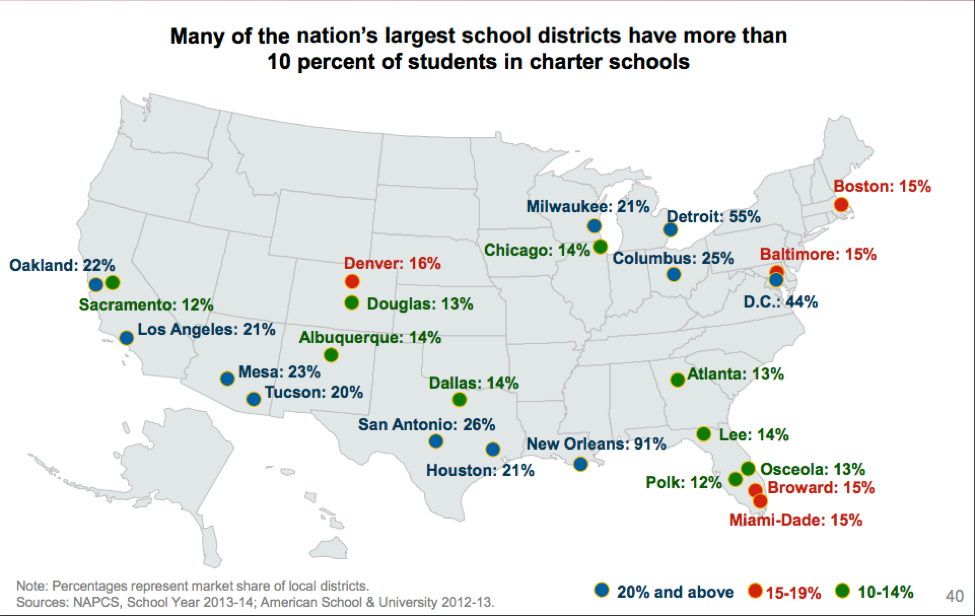
When the state mindset is on collaboration, legislative frameworks and SEA structures get passed down to the local level. In many states (like Georgia, Rhode Island, Massachusetts), they are framing their educational philosophy around personalized learning and really looking at whether or not schools are responding to family need.
According to the report data, looking into state level grants strategically can create positive incentives and capacity for local school leaders. Prioritizing start-up and two-way dissemination grants for both district and charter schools that commit to collaboration is one approach. They can create funding set-asides for cross-sector turnaround partnerships. Arizona and Massachusetts are good examples of states that took opposite approaches to how mindset can affect the local level. In Arizona, it’s a competition-based philosophy where the two sectors are meant to be independent and competing with each other. However, there’s still no collaboration at the local level in Arizona. In Massachusetts, there’s a strong partnership between traditional public schools and charters – in fact, charters were envisioned as the research and development department for the traditional sector and they built dissemination into the charter statute.
States can also encourage collaboration by resolving some tougher local conflicts. These conflicts revolve around two things:
- Access issues (enrollment, transportation, buildings, safety services)
- Funding issues (what level of fees should occur between the school and the authorizer)
One outcome is for the state to stipulate this, and direct charter funding from the state versus through the district.
States should consider their own sector neutrality and a “focus on what works” mindset rather than a “who works” mindset. They can also prioritize bilateral learning and strong partnerships in grants and turnaround efforts. It also works to resolve intractable local battles at the state level through legislation. One idea suggested for accomplishing this is to allow for shared test scores when there is school turnaround so that the whole city can claim the wins that the charter can provide. Other ideas toward ensuring that all students move toward improvement: encourage localities to adopt shared performance metrics, get schools to adopt shared enrollment systems, and promote objective standards for local authorizing.
The key takeaway here is that sectors working together locally can help states accomplish big goals toward school improvement and equity. Local collaboration efforts have only taken us so far, but the state can help drive them toward improvement. Effective state involvement in local collaboration requires intention, dedication and political savvy. Yatsko believes that states need to focus on small ways to make collaboration “sticky,” meaning, outlast the leaders involved and become sustainable.
“Interesting examples are in places like Sacramento, CA that didn’t go too far in terms of collaboration, but there was an agreement across districts and charter sectors around the leasing of charter schools and district facilities – it was a one year and changed to a five year lease.”
The CRPE will continue to research and track efforts to increase collaboration between traditional district and charter schools. CRPE team encourages contributions from those who feel their state’s viewpoint is not included in the current research. Reach out to them on their website.
 The National Alliance of Public Charter Schools is continuing their ongoing work to address common misunderstandings about charter schools, such as charter school funding. Their first campaign launched was “The Truth about Charter Schools,” which focused on myths repeated and the actual facts about charter schools. They created infographics and other materials shared across social media and advocacy outreach to various states that illustrated how these myths create confusion about charter school funding, what charter schools are and the important part they play in serving educational needs of students.
The National Alliance of Public Charter Schools is continuing their ongoing work to address common misunderstandings about charter schools, such as charter school funding. Their first campaign launched was “The Truth about Charter Schools,” which focused on myths repeated and the actual facts about charter schools. They created infographics and other materials shared across social media and advocacy outreach to various states that illustrated how these myths create confusion about charter school funding, what charter schools are and the important part they play in serving educational needs of students.
Their latest effort, #ChartersWork, addresses the current state of charter schools within today’s political climate. Even with the monumental growth over the past five years (three million students attending nearly 7,000 charter schools), the parent demand for more school choice goes unmet and there are still more than one million students on charter school waiting lists.
We are happy to support the National Alliance’s latest efforts toward busting common myths about charter schools. Stay tuned for our own series of Myths and Facts related to charter schools, their structure, their funding, and their facilities options.
 The Charter School Program (CSP) funding was increased in the House Labor -HHS Appropriations bill on July 13, 2017. The bill earmarks $28 million increase for CSP. Below is a statement from the National Alliance for Public Charter Schools with their position.
The Charter School Program (CSP) funding was increased in the House Labor -HHS Appropriations bill on July 13, 2017. The bill earmarks $28 million increase for CSP. Below is a statement from the National Alliance for Public Charter Schools with their position.
“…the House Labor-HHS Appropriations Subcommittee demonstrated support for public charter schools by recommending a $28 million increase to the Charter Schools Program (CSP), for a total of $370 million in FY 2018. This crucial funding would allow more high-quality public charter schools to open, expand and replicate—giving more students access to the great public school options they need and deserve. We are grateful to Chairman Cole, who provided this increase even when faced with a tight allocation that was several billions of dollars below last year’s level,” said Nina Rees, President and CEO of the National Alliance.
“However, the allocation remains too low, and must be raised. Once again, we urge Congress—in the strongest possible terms—to lift the cap on non-defense discretionary spending. We continue to support the Administration’s proposed level of $500 million for CSP in FY 2018. With a higher budget cap, Congress can reach that goal and provide students with even more access to public charter schools and other critical programs. We look forward to continued progress as the House bill moves to full committee and the Senate takes up its appropriations work.”
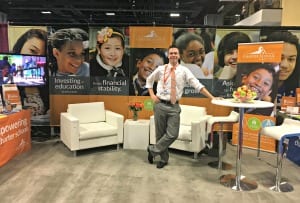 Our last two days at the National Charter Schools Conference were a dynamic mix of great keynotes, our second breakout session and lots of networking at our Booth #501.
Our last two days at the National Charter Schools Conference were a dynamic mix of great keynotes, our second breakout session and lots of networking at our Booth #501.
Tuesday started-off with a keynote by U.S. Secretary of Education, Betsy DeVos followed by a Q&A session facilitated by Derrell Bradford, Executive VP of 50CAN. Many charter leaders in attendance were eager to hear how DeVos planned to support charter schools with the current administration’s education budget cuts. DeVos talked about her early experience working to get the first charter school legislation passed in her home state of Michigan, where her husband also started a charter school focused on aviation and STEM.
Her main message to charter school leaders and advocates was to embrace all forms of school choice, including vouchers and tax credits for private schools. “Whatever your own journey looks like, we’re here because we came to the same conclusion that, as a nation, we are simply not doing a good enough job educating our kids,” said DeVos. Critics state that vouchers will divert funds from public schools — both traditional districts and charters.
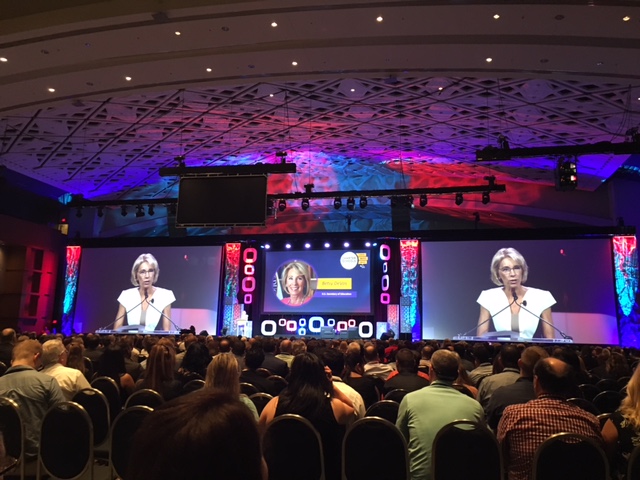 She also warned against becoming another education bureaucracy resistant to other forms of reform, and that charter schools should not be seen as a “cure-all to the ills that beset education.” DeVos summed up her stance this way, “Education is not a zero-sum game. We should not think of it as such. There is no one right way to help kids learn, and just because a school educates children differently than you might propose to does not make them the enemy. Let’s applaud and encourage others who serve students well. It’s a both/and situation, not an either/or.”
She also warned against becoming another education bureaucracy resistant to other forms of reform, and that charter schools should not be seen as a “cure-all to the ills that beset education.” DeVos summed up her stance this way, “Education is not a zero-sum game. We should not think of it as such. There is no one right way to help kids learn, and just because a school educates children differently than you might propose to does not make them the enemy. Let’s applaud and encourage others who serve students well. It’s a both/and situation, not an either/or.”
Other speakers from today’s general session included Marc Sternberg, K-12 Education Program Director of the Walton Family Foundation, Margaret Fortune, President and CEO of Fortune Schools, and last but not least, Reed Hastings, the CEO of Netflix. Although most know him for leading the company that has helped change the way people watch TV and movies, he is also well-known in the charter movement. Hastings has been a board member of KIPP charter schools for 10 years.
Hastings’ speech focused on two current trends in 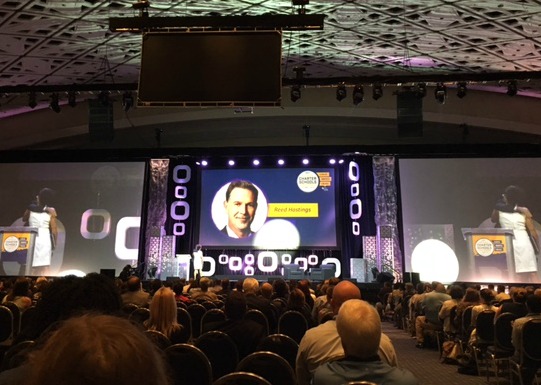 science — artificial intelligence, robotics and how these two areas contribute toward science and society. So how does this apply to charter schools and schools in general?
science — artificial intelligence, robotics and how these two areas contribute toward science and society. So how does this apply to charter schools and schools in general?
Hastings thinks that technology will continue to play an increasingly central role in education, in particular around personalization. Personalization in technology is what enables apps and services to offer information, content and products that are customized to fit an individual’s taste. Although he believes we will continue to see improvement, but we need to figure out how to deliver it one by one to people. The same concept applies to education – there is more school choice now than ever before, but more work needs to be done to accommodate the unique needs of every student.
His overall message was hopeful, but also requires a show of patience – “human society does change, but it changes slowly. Together, we have the excitement of changing it together.”
We also held our second breakout session on Tuesday, Digital Marketing 101 for Charter Schools – What You Need to Be Successful, which shared tips and best practices for charter schools who are interested in growing their student enrollment and engaging a community through digital marketing. Our panel of experts covered all bases around digital marketing trends and gave a quick rundown of the many tactics that charter schools can test out; including SEO, social media, PPC, retargeting advertising, video marketing, email marketing, and display advertising.
If you missed this session, or our other breakout session, I Need a Better Facility for My School: Now What?, on-demand recordings and slides are available here. You can also watch the Facebook Live recordings of the sessions here as well as on our Facebook page.
Wednesday’s half-day of sessions and the closing session with National Alliance of Public Charter School’s new VP of Advocacy, Amy Wilkins, provided a great wrap-up of many of the themes focused on this week — education, innovation and engagement. The panel particularly addressed ways to get school board members and legislators to take action on education-related bills and budget. Wilkins had two key takeaways: continue to use personal stories to show members why your students and schools are great, and have the courage to push the people whose lobbying we agree with to keep moving forward rather than just focusing on the opposition.
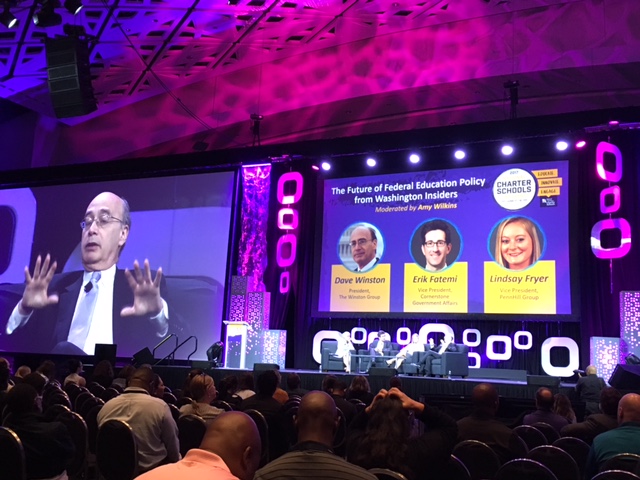
Fellow panel speakers, Dave Winston, President of The Winston Group, Erik Fatemi, VP of Cornerstone Government Affairs, and Lindsay Fryer, VP of the Penn Hill Group discussed the future of federal education policy. Recognizing that the current atmosphere on Capitol Hill is unsettled and tense since the education budget doesn’t reflect both parties’ desires, the panel discussed ways to stay focused on overall advocacy for charter schools and education.
“We must work hard and we must work together to build long-term, sustainable relationships with Congress,” concluded the Honorable Mary Landrieu, Former United States Senator from Louisiana. Her message to attendees — the more compelling your story and more organized your message, the better.
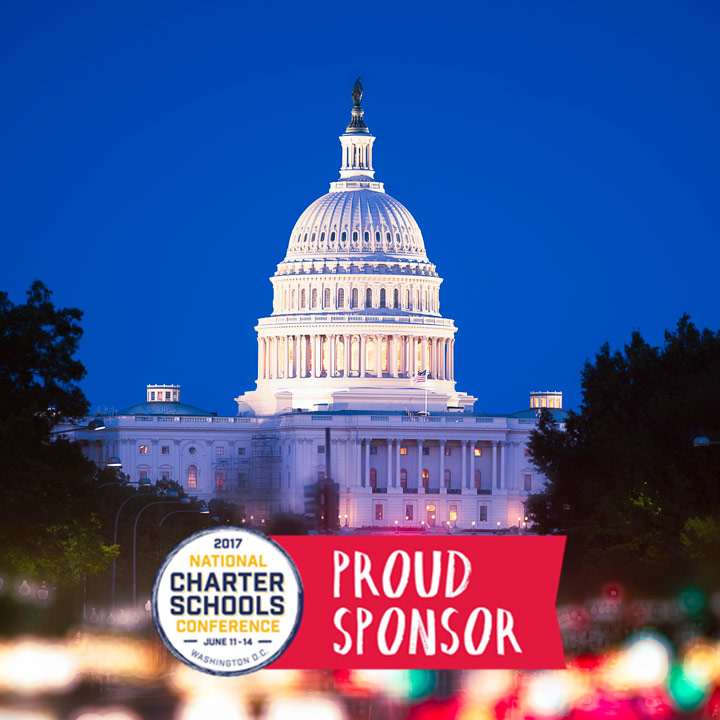 The Charter School Capital team is packing up and heading to Washington, D.C. next week, June 11-14. We’re proud to once again be one of the Gold Sponsors of the National Charter School Conference — you can find us in Booth #501 in the Exhibit Hall. And, our team is presenting at two breakout sessions as well.
The Charter School Capital team is packing up and heading to Washington, D.C. next week, June 11-14. We’re proud to once again be one of the Gold Sponsors of the National Charter School Conference — you can find us in Booth #501 in the Exhibit Hall. And, our team is presenting at two breakout sessions as well.
The theme of this year’s conference is Educate. Innovate. Engage. The content presented throughout the conference has a strong focus on what makes charter schools unique as well as new solutions to many of the common challenges all charter schools face. With so much going on, the theme will be well represented throughout the dozens of meet-ups, happy hour events and 100+ breakout sessions.
Solving challenges starts with sharing ideas. This year’s conference has a number of learning and networking sessions designed to break away from the traditional presentation model. The conference officially kicks-off on Sunday, June 11, with the Unconference which is a participant-determined and facilitated experience. With no script or agenda, the topics discussed will be solely determined by those attending. Attendees are invited to share what they’re learning with the hashtag #unconfNCSC.
Also happening throughout the conference, Charter Talks are similar to a Ted Talks style of short presentations focused on a big, compelling idea (in this case charter schools), and will be held in the Exhibit Hall during the lunch hour. Informal meetings will also be happening throughout the day, designed to bring together specific groups, such as charter school teachers, school board members and education leaders from different regions.
Keynote sessions will include presentations from Nina Rees, the President and CEO of the National Alliance of Public Charter Schools, Reed Hastings, CEO of Netflix and board member of many educational organizations, Dr. Steve Perry, Head of Capital Preparatory Schools, and Luis A. Miranda, Managing Partner of the Mirram Group.
Learn more about the conference and our two breakout sessions on our website. Hope to see you in D.C. Stop by our Booth #501 and say hi!
 We are presenting two breakout sessions at this year’s National Charter Schools Conference. One breakout session focuses on providing solutions to one of the most common challenges charter schools face —finding adequate facilities and the financing to secure them. The second is focused on using digital marketing best practices for student enrollment as well as engaging students and parents.
We are presenting two breakout sessions at this year’s National Charter Schools Conference. One breakout session focuses on providing solutions to one of the most common challenges charter schools face —finding adequate facilities and the financing to secure them. The second is focused on using digital marketing best practices for student enrollment as well as engaging students and parents.
Our first breakout session is on Monday, 6/12, from 11:15 a.m. to 12:30 p.m. Eastern, I Need a Better Facility for My School. Now What? addresses the challenges many charter leaders face in acquiring adequate charter school facilities. The panel includes Mike Morley, President and CEO at American Charter Development, Kevin Lynch, Senior Director of Cushman + Wakefield, and Michelle Lynch, Director of Regulatory Affairs, California Charter Schools Association. Our President and CEO, Stuart Ellis, will facilitate this session. Charter leaders will take away information around funding options available to charters, how to plan for facilities expansion and best practices for finding a facility that will best suit your school’s needs.
Our second breakout session is happening on Tuesday, 6/13, from 2:00 p.m. to 3:15 p.m. Eastern, Digital Marketing 101 for Charter Schools – What You Need to Be Successful. This panel includes Michael Barber, Founder and President of barber+hewitt and Scott Kauffman, Partner at Lucid Agency as well as our VP of Marketing Kim Brater. In this session, the focus is on best practices in digital marketing designed to aid charter leaders in student enrollment, retention and engaging with students and parents. The speakers will give an overview of the current digital landscape, cover the different types of digital marketing and give actionable tips that charter school leaders can immediately put into practice.
Also happening on Tuesday from 5:00 – 6:00 p.m. Eastern are the State Meetings at the conference, when many state associations will gather to network, catch-up and discuss issues and challenges particular to their state.
Our team is excited to take part in this national gathering of charter school leaders, educators and innovators in our nation’s capital.
If you’d like to follow along with what we’re doing at the conference, be sure to “like” our Facebook page. We’ll be live-streaming our breakout sessions outlined above for those not attending the conference. Be sure to also follow our LinkedIn company page and check our Twitter feed, where we’ll be live tweeting from our breakout sessions and other key events with the hashtags #NCSC17 and #GrowCharters.
If you’re at the conference, stop by our Booth #501 and say hi.
 JOIN OUR WEBINAR ON WEDNESDAY, MAY 31st!
JOIN OUR WEBINAR ON WEDNESDAY, MAY 31st!
Charter schools face many challenges during their stages of growth – whether start-up, expansion, or mature stage. It’s important for charter leaders to be prepared for each phase. Our webinar will focus on best practices charter leaders can implement today to help positively impact growth strategies for charter schools.
Join us on Wednesday, May 31st at 10:30 a.m. PDT / 1:30 p.m. EDT with panelists Bonnie Bensen, the CFO of Fortune School, Kapil Mathur, the Executive Director of Orange County Academy of Sciences and Arts, and Stuart Ellis, Charter School Capital’s President and CEO. They’ll be sharing their strategies around growth and replication, funding options specific to each growth stage and lessons learned from other charter school leaders.
REGISTER TODAY!